Prison statistics and population projections Scotland: 2011-12
This publication shows data up to 2011-12 on Scottish prison population levels and characteristics, receptions to/liberations from Scottish prisons, and international comparisons. This year it includes prison population projections to 2020-21 which were previously published separately, as well as additional background information and analyses.
This document is part of a collection
3. Prison statistics 2011-12: main findings
Prison population
4. After the slight dip observed last year, the prison population[1] has increased by 4 per cent to an annual daily average of 8,178 for 2011-12 (Table A.1). This represents a return to the overall rate of growth observed over the past decade, and population levels remain very high in relation to the current design capacity of about 7,840[2].
5. The prison population has shown short-term peaks and troughs over the past 20 years while the underlying longer term trend has been upward (Chart 3.1). The latest long-term projections suggest a continuing upward trend over the next ten years, and these are discussed in more detail in Section 4. It is also interesting to note that the rise in the prison population over the past five years or so is set against a backdrop of relatively stagnant or falling levels of recorded crime, and this is discussed further in Annex B.
Chart 3.1 Average daily prison population (Scotland): 1980 to 2011-12
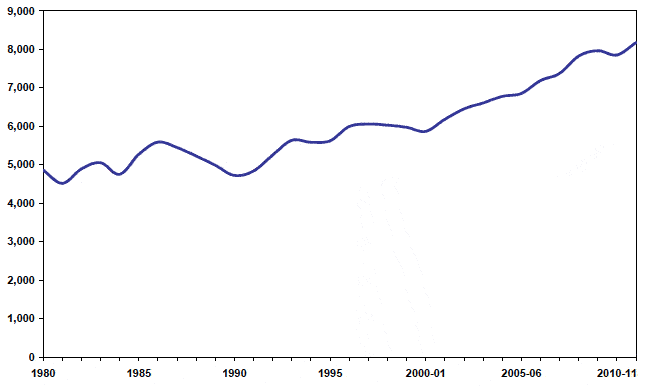
6. At a general level, there are several drivers behind the increase in prison population over the past couple of decades:
- increase in convictions for more serious offences and increased sentence lengths driving the general upward trend of the long-term prison population
- increase in the number of convicted offenders getting custodial sentences for lower level crimes and offences, coupled with improved efficiency of the criminal justice system, driving the increases in the short-term population seen during 2008 and 2009
- increased numbers of prisoners held on remand, particularly during 2006-07, 2008-09 and over the past year.
- increased numbers of recalls from supervision or licence over the past ten years, although this group accounts for a relatively small proportion of the prison population.
7. The current increase is primarily due to marked increases of 11 per cent in the adult remand population and a somewhat smaller increase of 4 per cent for the adult direct sentenced population (Table A.1, Chart 3.2).
Chart 3.2 Average daily prison population by category of prisoner: 2002-03 to 2011-12
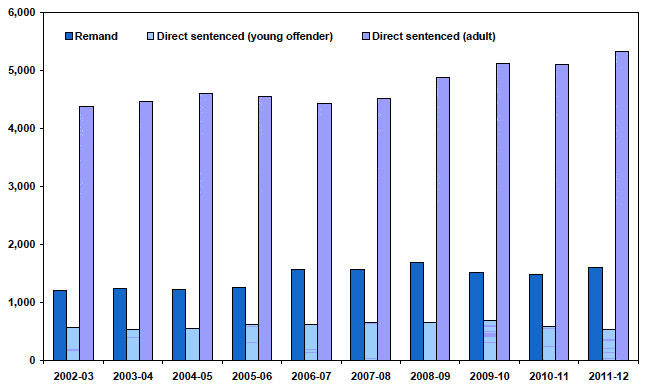
8. Overall, the sentenced population has increased by 3 per cent, reaching 6,578 in 2011-12. This is primarily due to marked increases in sentences between 3 months and two years (9 per cent overall), and more modest increases for the life sentence and recall populations which have increased by 5 and 3 per cent respectively (Table A.3). The increase in the population serving medium term sentences between six months and four years has been the most marked over the past two decades and trends for different sentence groups are discussed in more detail in Scottish prison population projections: 2010-11 to 2019-20 (Annex A).
9. Prisoners on remand or recalled from licence or supervision currently constitute just over a quarter of the prison population, although these categories have shown disproportionate increases over the past decade. The picture has become somewhat more complex over the past few years. The current annual rate of growth for the remand population is 9 per cent, reaching 1,600 during 2011-12, while the recall population has increased by 3 per cent to 701 (Table A.1).
10. Untried prisoners form the bulk of the remand population, 1,237 compared to 363 for remand prisoners who have been convicted but not sentenced. The untried population has gone up over the past year by 11 per cent, while the population of convicted remand prisoners awaiting sentencing has remained unchanged.
11. Since 2000, the female population has increased more rapidly than the male population. During 2011-12, the average daily population increased by 4 per cent to 7,710 for men, while the female population increased by 8 per cent to 468. The young offender population showed a marked drop for sentenced and a slight decrease for remand (8 and 1 per cent respectively), and this continues the downward trend observed since 2009-10 (Table A.1 and Table A.3). Historical trends for women and young offenders are discussed in more detail in Scottish prison population projections: 2010-11 to 2019-20 (Annex A), and the Commission for Women Offenders set up by the Scottish Government in 2011 has recently published a report examining more effective ways of dealing with women offenders with a view to reducing reoffending.
12. Most of the population figures reported in this bulletin are annual daily averages during 2011-12: the population peaked at 8,461 in March 2012 (Table A.2). More generally, seasonal effects and a range of other, potentially unforeseeable, events may result in short-term fluctuations in the prison population which can be of the order of +/- 300-400. The prison estate has to accommodate prisoners with differing needs, for instance, remand/sentenced, short/long term, as well as those at different stages of progression and security levels. Some groups need separate accommodation, such as women and young offenders, and fluctuations in these groups therefore cause additional service delivery problems[3].
Population profile
13. The prison population on 30 June 2011 was 8,106, of which 94 per cent were men (Table A.4). The age profile of women prisoners tends to be somewhat older than that for men (Chart 3.3).
Chart 3.3 Age distribution of prisoners by sex: 30 June 2011
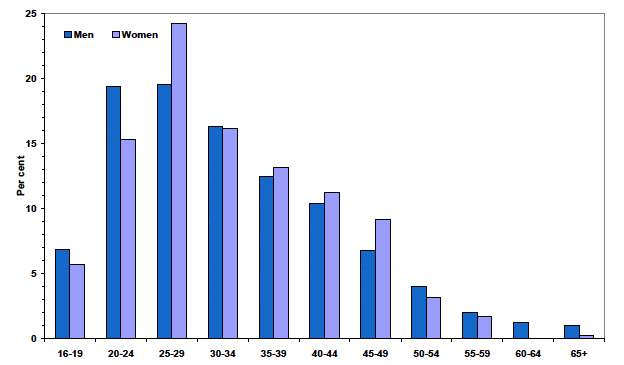
14. Three fifths of the prison population had a medium supervision level, and 7 per cent had a high supervision level. The remaining third had a low level of supervision (Table A.4, see Section 5 for details on supervision levels).
15. The crime category with the largest population of sentenced prisoners on 30 June 2011 was non-sexual violent crime (35 per cent), followed by the other crimes category (20 per cent). The latter category consists mainly of drugs-related crimes, which make up 13 per cent of the total (Table A.5, see Section 5 for classification of crimes/offences). This pattern is identical to that from the previous year.
16. The incarceration rate per 100,000 16+ population is highest for Dundee (377) and Glasgow (332), followed by West Dunbartonshire (275). Inverclyde, North and East Ayrshire and North Lanarkshire also have relatively high imprisonment rates. Orkney has the lowest rate (54), followed by Aberdeenshire (58), Scottish Borders (61), and East Dunbartonshire (64) (Table A.6). There is a strong correlation between imprisonment rates and area deprivation, and more details on this can be found in the 2005 report by Roger Houchin Social exclusion and imprisonment in Scotland.
Home detention curfew
17. Release on home detention curfew (HDC) for low risk prisoners nearing the end of their sentence was implemented in July 2006. The average daily population on HDC has been falling slightly since a peak of about 370 in 2008-09 and 2009-10 to about 360 over the past two years. The number of releases from prison on HDC was 1,942, an increase of 7 per cent compared to the previous year (Table A.8). The rate of recall in terms of the number of recalls as a proportion of releases during a period gives an annual nominal recall rate of 20 per cent. A detailed analysis of the use of HDC since 2006 can be found in the Scottish Government research report Evaluation of the use of Home Detention Curfew and the Open Prison Estate in Scotland.
Receptions
18. Receptions[4] tend to show some year on year variation (Chart 3.4): the overall trend has been downward since 2006-07, although the most recent figures show an increase of 3 per cent. Remand receptions have on the whole drifted downward since 2006-07, but have picked up over the past two years: the most recent figures show an increase of 3 per cent (Table A.9).
19. Sentenced receptions have also increased over the past year by 3 per cent, driven by increases in the adult direct sentenced group, after a drop over the previous two years (Table A.9).
Chart 3.4 Prison receptions by custody type: 2002-03 to 2011-12
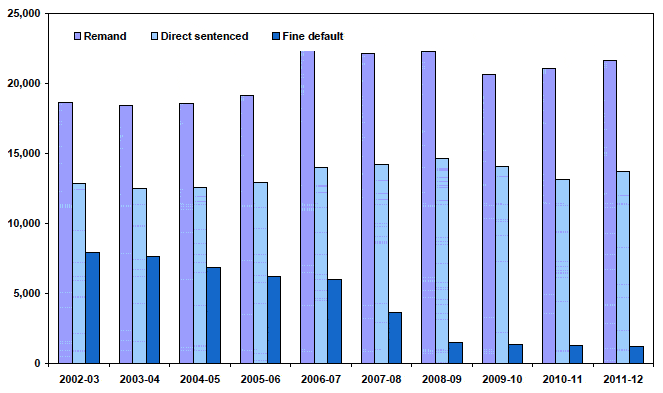
Direct sentenced receptions
20. The bulk of the general rise in direct sentenced receptions up to 2008-09 is due to increasing volumes of lower level crimes and offences. These include handling offensive weapons, drugs-related crimes, crimes against public justice (such as contempt of court, perjury and bail offences), common assault and breach of the peace (Table A.12, see Section 5 for classification of crimes/offences). The rate of increase has been particularly marked since 2003-04, with some degree of levelling-off in recent years as noted in §19. Trends for receptions by crime type are discussed in more detail in Scottish prison population projections: 2010-11 to 2019-20 (Annex A).
21. In terms of types of crimes and offences , the most notable area of change over the past year are receptions for crimes of violence, particularly robbery (up by 28 per cent) and serious assault (up by 11 per cent). Drugs related crimes have fallen by 7 per cent (Table A.12).
22. The average sentence length has fluctuated somewhat over the past 10 years, with a consistent increase over the past four years to 358 days for 2011-12 (Table A.13 and Chart 3.5). Readers should note that where several sentences are to be served consecutively, the sentence length recorded is the total length of the combined sentences. The average sentence length shown here will therefore differ somewhat from that recorded in the Scottish Government criminal proceedings data.
Chart 3.5 Average sentence imposed (days): 2002-03 to 2011-12
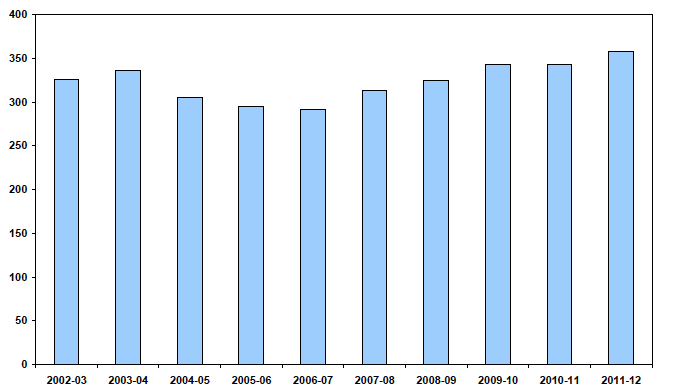
23. The shift in balance between less serious and more serious crimes highlighted in §20 appears to have had a short term impact between 2003-04 and 2006-07 in terms of a drop in the average sentence length. However, the increase in receptions for crimes of violence over the past 20 years will have a greater impact on the prison population in the longer term as these tend to result in heavier sentences (Table A.12, see Annex A in Scottish prison population projections: 2010-11 to 2019-20 for a discussion of the longer term trends).
International comparisons of prison population
24. Scotland's incarceration rate per 100,000 population is 154, similar to England and Wales (155) and Spain (152) (Chart 3.6). This is higher than most other European Union countries, particularly the Nordic countries, but substantially lower than the US, the Russian Federation and the Baltic states (Table A.16). Comparisons of the prison population in different jurisdictions should be treated with caution due to the different justice systems and recording rules in operation. Further information, including time series, can be found in the Council of Europe Annual Penal Statistics (SPACE) publications.
Chart 3.6 Incarceration rate per 100,000 population by jurisdiction: 2011
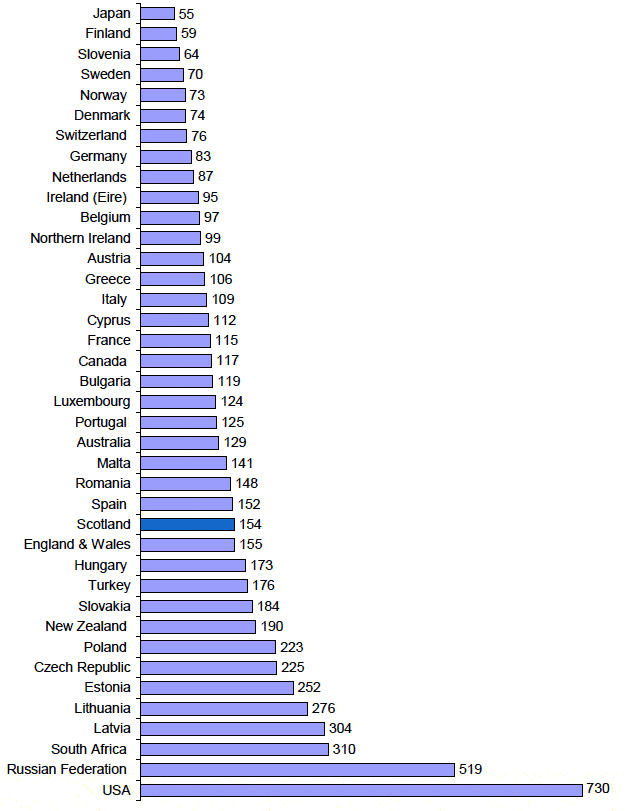
Trends in the prison population
25. The prison population has been increasing steadily since the early 2000s, with a particularly marked rate of increase between 2005-06 and 2008-09.
Seasonality
26. What is also notable is how seasonality has varied over the past five years. Population levels have traditionally shown an increase in March-April which follows a marked dip over December-January (Chart 3.7). There also tends to be a lull over the summer months before the figures rise again to peak in the autumn. The seasonal lows mainly reflect slowdowns associated with holiday periods, such as reduced number of court sitting days, although the most recent dip at the end of 2010 has been attributed in part to the extreme weather conditions during that period affecting the propensity to commit crimes, as well as police capacity to respond.
Chart 3.7 Average daily prison population: January 2007 to December 2011
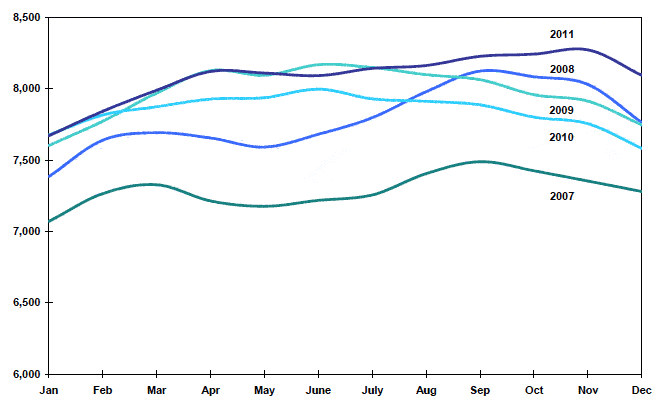
27. In 2007, the population shows the expected seasonal patterns, as does 2011 to some extent, apart from a more long-lived gradual increase in the second half of the year. This is in contrast to 2008, where there were marked increases during the second half of the year, while 2009 and 2010 show big increases until the mid-year, followed by a gradual decline.
Prisoner type
28, While there has been an increase in numbers overall, the patterns of change have not been the same for all segments of the prison population (Chart 3.8). The increase in the long-term population sentenced to four years or more has been gradual over the years, from an average daily population of about 2,500 in 2000 to 3,100 in the second half of 2010 and during 2011.
29. The average daily population of remand prisoners increased sharply during 2006 from about 1,200, stabilising at 1,600 in 2007 before increasing further during 2008 to reach a peak of 1,800. This was the main reason for the increased prison population in 2006 and one of the contributing factors to the high prison population in 2008. The more recent figures show a consistent fall overall since mid 2008 to about 1,400 during the second half of 2010, followed by a increase to about 1,600 during 2011.
30. However, the main driver for the record population levels seen during 2008 and 2009 were the numbers of short-term prisoners sentenced to less than four years. The average daily population for this group increased steadily since 2007, from approximately 2,600 to 3,000, with the rate of increase accelerating markedly during 2008 and 2009 to reach 3,500. Population levels then dropped slightly by about 100 during the latter half of 2010, staying at about 3,400 during 2011. The main increase has been for the medium term sentences, as discussed in §8.
Chart 3.8 Average daily prison population: January 2000 to December 2011
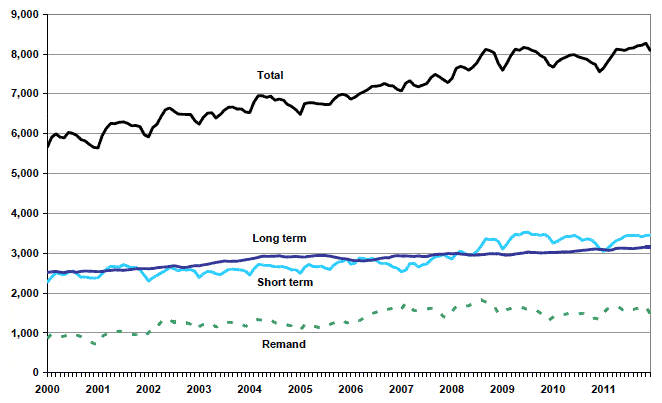
Note: Long-term population includes recalls and life sentences.
Potential influences
31. There have been a series of initiatives over the past decade, primarily aimed at improving the efficiency of the criminal court system as a result of the Bonomy and McInnes reviews of high and sheriff summary court procedures, as well as the Sentencing Commission for Scotland review of the use of bail and remand. These include:
- Increased sentencing powers
- Maximum sentence for sheriff solemn cases increased from three to five years (May 2004)
- Maximum sentence for sheriff summary cases increased from three to 12 months, with additional penalties for failing to comply with bail conditions (December 2007)
- Increased powers for Justice of the Peace courts to deal with a wider range of road traffic offences (March 2008).
- Reforms to bail procedures
- Judges to provide reasons for granting/refusing bail
- 'Exceptional circumstances' test for bail where an accused in solemn proceedings for a violent, sexual or drug trafficking offence has a previous similar solemn conviction
- Attitude of prosecutor no longer restricts the power of the court so the court can now refuse bail even if the prosecutor does not oppose bail (December 2007).
- Changes in public prosecution policy
- Revised Crown Office and Procurator Fiscal Service (COPFS) policy on knife crime with a presumption of prosecution in solemn courts and opposition to bail for repeat offenders (June 2006, further tightening of policy on knife crime with guidelines issued June 2011)
- Revised COPFS case marking guidelines with a presumption in favour of action and an outcome focused approach to increase likelihood of conviction. Where court action is appropriate, this will take place in the lowest appropriate forum (March 2008).
- Legal Aid reform
- Payments to solicitors front-loaded to encourage early pleas (June 2008).
32. These changes are likely to have contributed to the observed increases in the prison population between 2006 and 2009 but the effect appears to have washed out to some extent.
33. Changes in police activity, both in the short and long term, may affect the prison population to some extent. For instance, over the past ten years there have been increasing volumes of prison receptions for relatively low-tariff crimes and offences such as crimes against public justice, handling offensive weapons, common assault and breach of the peace (see Annex A in Scottish prison population projections: 2010-11 to 2019-20 for more details). However, while this may reflect an increased police focus in these areas, the trend will also be affected by prosecution and sentencing practice, such as those described above.
34. Other changes in policy and practice, particularly in terms of alternatives to custody, are also likely to impact on sentencing patterns and affect the prison population in the longer term. In particular, the Scottish Prisons Commission report Scotland's choice made strong recommendations regarding greater use of alternatives to custody, a position which has been endorsed in the Scottish Government paper Protecting Scotland's communities: fair, fast and flexible justice. One of the key principles in the Prisons Commission report was that custody should be used only when it is needed to reflect the seriousness of the offence and for those who pose a risk of harm, while community sentences should be the norm for less serious offenders.
35. One response has been the introduction of the Community Payback Order and a presumption against custodial sentences of three months or less in February 2011. The Community Payback Order gives courts the flexibility to impose one or more of a range of requirements, depending on the nature of the crime and any underlying issues that need to be addressed in order to prevent re-offending. It is still early days in terms of assessing the likely impact of these changes on the prison population in the short to medium term as this will depend on how they are implemented by the judiciary. Prison population figures for 2011-12 suggest there has been little impact on the population with sentences of three months or less over and above the secular trend (Annex D). However, readers should note that in cases where several sentences are to be served consecutively, the sentence length recorded is the total length of the combined sentences. The prisons data will therefore underestimate the number of short sentences, and users are advised to use the Scottish Government criminal proceedings data if they wish a more accurate reflection of trends in sentencing.
36. Implementing the recommendations of the Bowen review of sheriff and jury procedure may also impact on the prison population, although again it is too early to determine the nature and timing of such impacts.
Contact
There is a problem
Thanks for your feedback